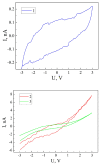The Accumulation of Electrical Energy Due to the Quantum-Dimensional Effects and Quantum Amplification of Sensor Sensitivity in a Nanoporous SiO2 Matrix Filled with Synthetic Fulvic Acid
- PMID: 37112503
- PMCID: PMC10145198
- DOI: 10.3390/s23084161
The Accumulation of Electrical Energy Due to the Quantum-Dimensional Effects and Quantum Amplification of Sensor Sensitivity in a Nanoporous SiO2 Matrix Filled with Synthetic Fulvic Acid
Abstract
A heterostructured nanocomposite MCM-41<SFA> was formed using the encapsulation method, where a silicon dioxide matrix-MCM-41 was the host matrix and synthetic fulvic acid was the organic guest. Using the method of nitrogen sorption/desorption, a high degree of monoporosity in the studied matrix was established, with a maximum for the distribution of its pores with radii of 1.42 nm. According to the results of an X-ray structural analysis, both the matrix and the encapsulate were characterized by an amorphous structure, and the absence of a manifestation of the guest component could be caused by its nanodispersity. The electrical, conductive, and polarization properties of the encapsulate were studied with impedance spectroscopy. The nature of the changes in the frequency behavior of the impedance, dielectric permittivity, and tangent of the dielectric loss angle under normal conditions, in a constant magnetic field, and under illumination, was established. The obtained results indicated the manifestation of photo- and magneto-resistive and capacitive effects. In the studied encapsulate, the combination of a high value of ε and a value of the tgδ of less than 1 in the low-frequency range was achieved, which is a prerequisite for the realization of a quantum electric energy storage device. A confirmation of the possibility of accumulating an electric charge was obtained by measuring the I-V characteristic, which took on a hysteresis behavior.
Keywords: encapsulate; impedance spectroscopy; photo- and magneto-resistive and capacitive effects; quantum battery; silicon dioxide matrix; synthetic fulvic acid.
Conflict of interest statement
The authors declare no conflict of interest.
Figures








Similar articles
-
Composites Based on Cotton Microfibers Impregnated with Magnetic Liquid for Magneto-Tactile Sensors.Materials (Basel). 2023 Apr 19;16(8):3222. doi: 10.3390/ma16083222. Materials (Basel). 2023. PMID: 37110059 Free PMC article.
-
Influence of Annealing on the Dielectric Properties of Zn-SiO2/Si Nanocomposites Obtained in "Hot" Implantation Conditions.Nanomaterials (Basel). 2022 Oct 2;12(19):3449. doi: 10.3390/nano12193449. Nanomaterials (Basel). 2022. PMID: 36234577 Free PMC article.
-
How Molecular Mobility, Physical State, and Drug Distribution Influence the Naproxen Release Profile from Different Mesoporous Silica Matrices.Mol Pharm. 2021 Mar 1;18(3):898-914. doi: 10.1021/acs.molpharmaceut.0c00908. Epub 2021 Jan 18. Mol Pharm. 2021. PMID: 33461296
-
Dielectric Property and Space Charge Behavior of Polyimide/Silicon Nitride Nanocomposite Films.Polymers (Basel). 2020 Feb 4;12(2):322. doi: 10.3390/polym12020322. Polymers (Basel). 2020. PMID: 32033131 Free PMC article.
-
Effect of ultraviolet illumination and ambient gases on the photoluminescence and electrical properties of nanoporous silicon layer for organic vapor sensor.J Nanosci Nanotechnol. 2012 Aug;12(8):6602-7. doi: 10.1166/jnn.2012.4532. J Nanosci Nanotechnol. 2012. PMID: 22962795
References
-
- Ibrahim I.D., Sadiku E.R., Jamiru T., Hamam Y., Alayli Y., Eze A.A. Prospects of Nanostructured Composite Materials for Energy Harvesting and Storage. J. King Saud Univ.—Sci. 2020;32:758–764. doi: 10.1016/j.jksus.2019.01.006. - DOI
-
- Macagnano A., Avossa J. Advances in Nanostructured Materials and Nanopatterning Technologies. Elsevier; Amsterdam, The Netherlands: 2020. Nanostructured composite materials for advanced chemical sensors; pp. 297–332. - DOI
-
- Wang B. Mechanics of Advanced Functional Materials. Springer; Berlin/Heidelberg, Germany: 2013. Size and Surface Effects of Phase Transition on Nanoferroelectric Materials; pp. 179–268. - DOI
-
- Eliseev E.A., Kalinin S.V., Morozovska A.N. Finite size effects in ferroelectric-semiconductor thin films under open-circuit electric boundary conditions. J. Appl. Phys. 2015;117:034102. doi: 10.1063/1.4906139. - DOI
LinkOut - more resources
Full Text Sources

